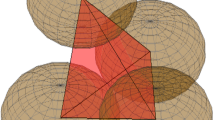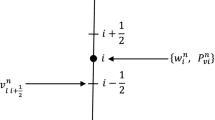Abstract
In the present work, the effect on the soil moisture profiles development and the cumulative infiltration when three different equations for calculating the diffusivity versus volumetric water content, D(θ) function, from one-step outflow experimental data are used, is investigated. These D(θ) functions are coupled with moisture retention curves θ(h) (h being the soil matric potential) obtained independently for the determination of the hydraulic conductivity function K(θ) or K(h). The so obtained hydraulic conductivity function, together with θ(h), were employed in solving Richards equation numerically under constant flux conditions in one dimensional vertical infiltration process. Two different porous materials were used for this investigation. It is shown that the three different equations used for the prediction of K(h) have no significant effect on the shape of the moisture profiles for the sand mixture and that a Green–Ampt advancement of the wetting front is observed. For the case of sandy clay soil there are some noticeable differences in the moisture profiles and their shape is comparatively more effusive. Also, one could mention that for both porous media the time of incipient ponding (T) differentiates among the three equations used.
Similar content being viewed by others
References
Brutsaert W (1967) Some methods of calculating unsaturated permeability. Trans ASAE 10:400–404
Childs EC, Collis-George N (1950) The permeability of porous materials. Proc R Coc Ser A 201:392–405. doi:10.1098/rspa.1950.0068
Doering EJ (1965) Soil water diffusivity by one-step method. Soil Sci 99:322–326. doi:10.1097/00010694-196505000-00005
Eching SO, Hopmans JW, Wendroth O (1994) Unsaturated hydraulic conductivity from transient multi-step outflow and soil pressure data. Soil Sci Soc Am J 58:687–695
Gardner WR (1960) Dynamic aspects of water availability to plants. Soil Sci Soc Am Proc 26:63–73
Gardner WR (1962) Note on the separation and solution of diffusion type equations. Soil Sci Soc Am Proc 38:710–716
Green WH, Ampt GA (1911) Studies in soil physics I. The flow of air and water through soils. J Agric Sci 4:1–24. doi:10.1017/S0021859600001441
Green TW, Paydar Z, Cresswell HP, Drinkwater RJ (1998) Laboratory outflow technique for measurement of soil water diffusivity and hydraulic conductivity. CSIRO, February 1998, Technical report no. 12/98
Gupta SC, Farrel DA, Larson WE (1974) Determining effective soil water diffusivities from one-step outflow experiments. Soil Sci Soc Am Proc 38:701–716
Haverkamp R, Vauclin M, Touma J, Wierenga PJ, Vachaud G (1977) A comparison of numerical simulation models for one-dimensional infiltration. Soil Sci Soc Am J 41:285–296
Hopmans JW, Simunek J, Romano N, Durner W (2002) Water retention and storage: inverse methods. In: Dane JH, Topp GC (eds) Methods of soil analysis part 4—physical methods. SSSA book series no. 5. SSSA, Madison, pp 963–1004
Kerkides P, Poulovassilis A, Argyrokastritis I, Elmaloglou S (1997) Comparative evaluation of analytic solutions in predicting soil moisture profiles in vertical one-dimensional infiltration under ponded and constant flux boundary conditions. Water Resour Manag 11(5):323–338. doi:10.1023/A:1007978714468
Mishra SK, Pandey RP, Jain MK, Singh VP (2008) A rain duration and modified AMC-dependent SCS-CN procedure for long duration rainfall-runoff events. Water Resour Manag 22(7):861–876. doi:10.1007/s11269-007-9196-6
Parker JC, Kool JB, van Genuchten MT (1985) Determining soil hydraulic properties from one-step outflow experiments by parameter estimation: II. Experimental studies. Soil Sci Soc Am J 49:1354–1359
Passioura JB (1976) Determining soil water diffusivities from one-step outflow experiments. Aust J Soil Res 15:1–8. doi:10.1071/SR9770001
Poulovassilis A, Kerkides P, Elmaloglou S, Argyrokastritis I (1991) An investigation of the relationship between ponded and constant flux infiltration. Water Resour Res 27:1403–1409. doi:10.1029/91WR00160
Valiantzas JD (1989) A simple approximate equation to calculate diffusivities from one-step outflow experiments. Soil Sci Soc Am J 53:342–349
Valiantzas JD, Kerkides PG (1990) A simple iterative method for the simultaneous determination of soil hydraulic properties from one-step outflow data. Water Resour Res 26:143–152
Valiantzas JD, Kerkides PG, Poulovassilis A (1988) An improvement to the one-step outflow for the determination of soil water diffusivities. Water Resour Res 24:1911–1920. doi:10.1029/WR024i011p01911
Van Dam JC, Stricker JNM, Droogers P (1992) Inverse method for determining soil hydraulic functions from one-step outflow experiments. Soil Sci Soc Am J 56:1042–1050
Van Dam JC, Stricker JNM, Droogers P (1994) Inverse method for determining soil hydraulic functions from multi-step outflow experiments. Soil Sci Soc Am J 58:647–652
van Genuchten MT (1980) A closed form equation for the predicting the hydraulic conductivities of unsaturated soils. Soil Sci Soc Am J 44:892–898
van Genuchten MT, Leij FJ, Yates SR (1991) The RETC code for quantifying the hydraulic functions of unsaturated soil EPA/600/2-91-065. EPA Office of Research and Development, Washington DC
Venkata RK, Eldho TI, Rao EP, Chithra NR (2008) A distributed kinematic wave-Philip infiltration watershed model using FEM, GIS and remotely sensed data. Water Resour Manag 22(6):735–755. doi:10.1007/s11269-007-9189-5
Author information
Authors and Affiliations
Corresponding author
Rights and permissions
About this article
Cite this article
Argyrokastritis, I., Kargas, G. & Kerkides, P. Simulation of Soil Moisture Profiles Using K(h) from Coupling Experimental Retention Curves and One-Step Outflow Data. Water Resour Manage 23, 3255–3266 (2009). https://doi.org/10.1007/s11269-009-9432-3
Received:
Accepted:
Published:
Issue Date:
DOI: https://doi.org/10.1007/s11269-009-9432-3




